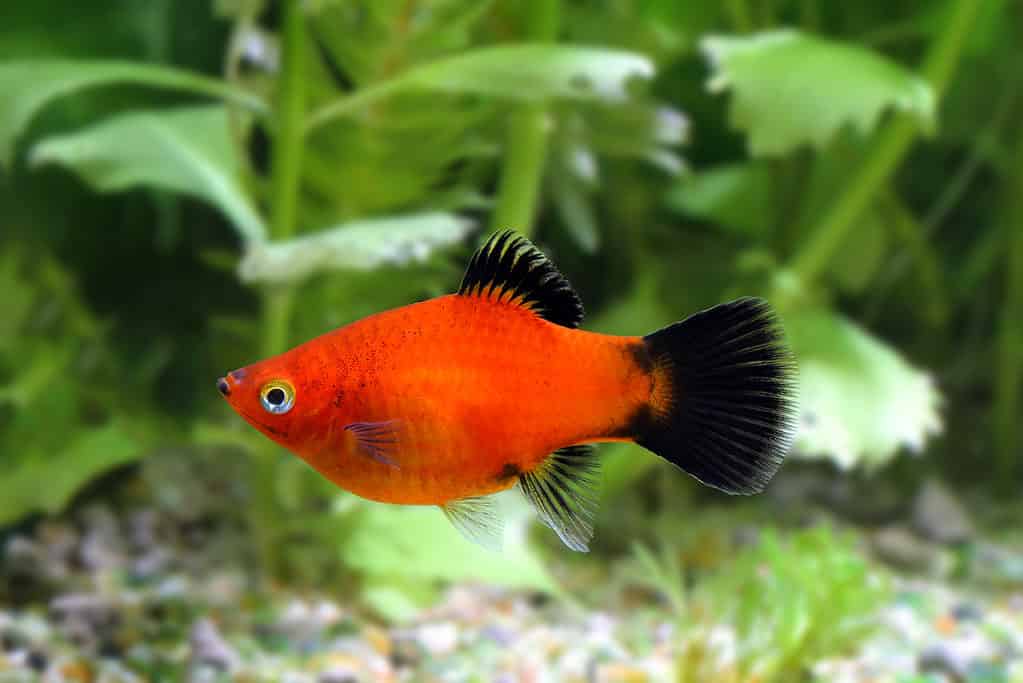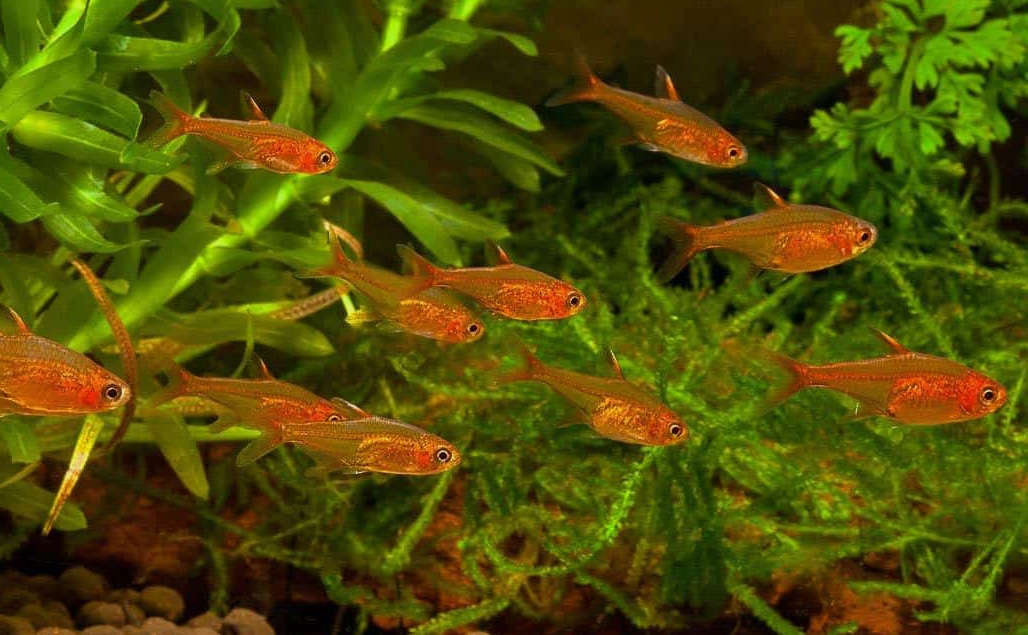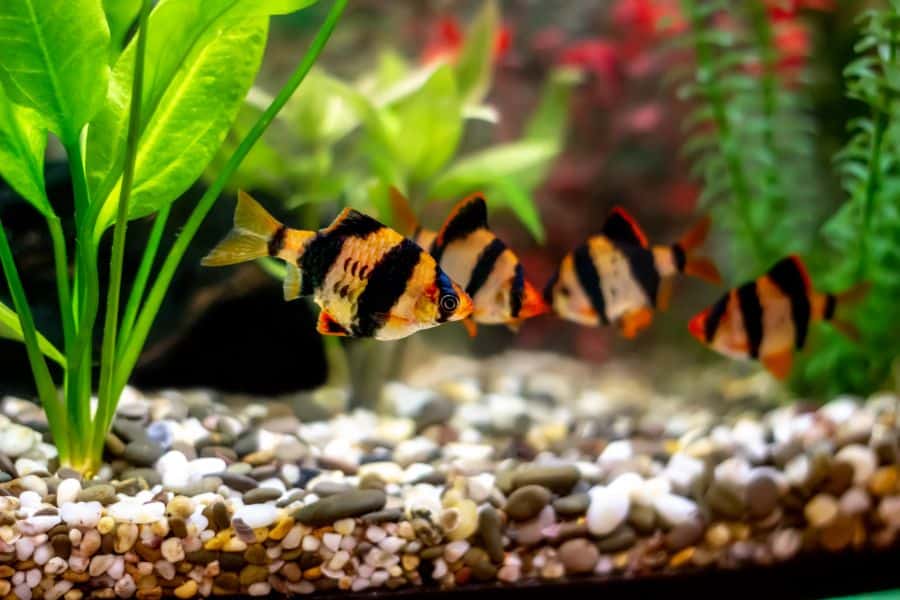Freshwater aquariums are a great way to bring a piece of nature into your home. One of the most exciting aspects of setting up an aquarium is choosing the fish to populate it.
If you’re looking for a splash of color, orange freshwater fish are a great option. In this article, we’ll explore the top 8 best orange freshwater fish perfect for aquariums. Whether you’re a beginner or an experienced aquarist, there’s sure to be a fish on this list that catches your eye.
You are reading: The Top 8 Best Orange Freshwater Fish Perfect For Aquariums

Top 8 Best Orange Freshwater Fish Perfect For Aquariums
Ember Tetra Fish

Ember tetras are a popular choice for freshwater aquariums due to their striking orange color and active, social behavior. These small fish are part of the characin family and are native to the Araguaia River basin in Brazil.
Ember tetras are well-suited for nano aquariums and are adaptable to a range of water conditions, including pH levels of 5.5-7.5 and temperatures of 72-82°F. They are omnivores and enjoy eating zooplankton, small invertebrates, and plant matter.
Ember tetras are peaceful and can be kept with other similar-sized, peaceful fish such as rasboras, tetras, and danios. They swim at the middle level of the aquarium and should be kept with bottom-dwelling fish like pygmy corydoras to ensure leftover food is eaten up off the substrate.
Overall, ember tetras are a great choice for beginner and experienced aquarists alike.
Tiger Barb

Tiger barbs are a popular choice for freshwater aquariums due to their striking orange color and active, social behavior. Here are some key facts about tiger barbs:
Appearance:
– Tiger barbs are a species of tropical cyprinid fish that can grow up to 3 inches long.
– They have a distinctive orange color with black stripes, resembling a tiger.
Behavior:
– Tiger barbs are active shoaling fish that should be kept in groups of six or more.
– They can be aggressive towards other fish, especially if kept in small numbers.
– Tiger barbs are known to nip at the fins of other fish, especially if they are wounded or injured.
– They can be kept with other fast-swimming fish such as zebra danios and silver tip tetras, or larger fish that won’t eat them such as clown loaches and certain South American cichlids.
Care:
– Tiger barbs are hardy fish that can tolerate a wide range of water conditions, including pH levels of 6.0-8.0 and temperatures of 72-82°F.
– They do best in soft, slightly acidic water.
– The ideal tank for tiger barbs should have a large open area for swimming with an abundance of live or artificial plants around the periphery of the tank.
– Tiger barbs are omnivores and will eat a variety of foods, including flakes, pellets, frozen and live foods.
Read more : The 6 Types Of Tiger Species From Around The World
Overall, tiger barbs are a great choice for aquarists who want to add a splash of color and activity to their aquarium. However, it’s important to keep them in groups of six or more and choose tankmates carefully to avoid aggression.
Orange Sailfin Molly
The orange sailfin molly is a popular freshwater fish that is known for its bright orange color and distinctive sail-like dorsal fin. Here are some key facts about the orange sailfin molly:
Appearance:
– The orange sailfin molly is a type of Poecilia latipinna, a species of livebearer fish that can grow up to 3 inches long.
– As the name suggests, the orange sailfin molly has a bright orange color with a sail-like dorsal fin.
– Some strains of orange sailfin molly may have black streaking or cream freckling, but breeders are working to develop a solid orange strain.
Behavior:
– Orange sailfin mollies are peaceful fish that can be kept in community tanks with other peaceful fish.
– They are active swimmers and enjoy having plenty of space to swim around.
– Orange sailfin mollies are livebearers, meaning they give birth to live young instead of laying eggs.
Care:
– Orange sailfin mollies are hardy fish that can tolerate a wide range of water conditions, including pH levels of 7.0-8.5 and temperatures of 70-82°F.
– They prefer slightly alkaline water with a moderate to high level of hardness.
– The ideal tank for orange sailfin mollies should have plenty of plants and hiding places, as well as open swimming areas.
– Orange sailfin mollies are omnivores and will eat a variety of foods, including flakes, pellets, and live or frozen foods.
Overall, the orange sailfin molly is a great choice for aquarists who want a colorful and active fish that is easy to care for. They are peaceful and can be kept in community tanks, and their hardy nature makes them a good choice for beginners.
Orange Venezuelan Cory Catfish
The Orange Venezuelan Cory Catfish is a natural geographic color variant of the Bronze Cory Catfish, and is known for its bright orange coloration. Here are some key facts about the Orange Venezuelan Cory Catfish:
Appearance:
– The Orange Venezuelan Cory Catfish has a bright orange coloration with a white underbelly.
– It has a typical corydoras body shape, with a flattened head and a series of bony plates along its sides.
Behavior:
– Orange Venezuelan Cory Catfish are peaceful and social fish that should be kept in groups of at least six.
– They are bottom-dwelling fish that enjoy having plenty of hiding places, such as caves or plants.
– Orange Venezuelan Cory Catfish are active scavengers that will eat leftover food and other debris from the bottom of the tank.
Care:
– Orange Venezuelan Cory Catfish are hardy fish that can tolerate a wide range of water conditions, including pH levels of 6.8-7.0 and temperatures of 72-78°F.
– They prefer soft to moderately hard water with a neutral to slightly acidic pH.
– The ideal tank for Orange Venezuelan Cory Catfish should have a sandy substrate and plenty of hiding places.
– They are omnivores and will eat a variety of foods, including flakes, pellets, and live or frozen foods.
Overall, the Orange Venezuelan Cory Catfish is a great choice for aquarists who want a colorful and social bottom-dwelling fish. They are hardy and easy to care for, and their scavenging behavior can help keep the tank clean.
Orange Dwarf Gourami
The Orange Dwarf Gourami is a popular freshwater fish that is known for its bright orange-red body with turquoise-blue, vertical stripes that extend into the fins. Here are some key facts about the Orange Dwarf Gourami:
Appearance:
– The Orange Dwarf Gourami is one of the smallest of the gouramis, with males being slightly larger than females.
– Males have a bright orange-red body with turquoise-blue, vertical stripes that extend into the fins, while females are less colorful.
Behavior:
– Orange Dwarf Gouramis are peaceful fish that can be kept in community tanks with other peaceful fish of similar size and temperament.
– They are top and mid-dwelling fish that enjoy having plenty of hiding places, such as plants and caves.
– Orange Dwarf Gouramis are labyrinth fish, meaning they have a special organ that allows them to breathe air from the surface of the water.
Care:
– Orange Dwarf Gouramis are hardy fish that can tolerate a wide range of water conditions, including pH levels of 6.0-7.5, temperatures of 72-82°F, and hardness of 4 to 10 dGH.
– They prefer slightly acidic to neutral water with a moderate level of hardness.
– The ideal tank for Orange Dwarf Gouramis should have plenty of plants and hiding places, as well as open swimming areas.
– They are omnivores and will eat a variety of foods, including flakes, pellets, and live or frozen foods.
Overall, the Orange Dwarf Gourami is a great choice for aquarists who want a colorful and peaceful fish that is easy to care for. They are hardy and adaptable to a range of water conditions, and their labyrinth organ allows them to breathe air from the surface of the water.
Orange Swordtail Fish
The Orange Swordtail Fish is a popular freshwater fish that is known for its bright orange coloration and sword-like extension on its tail.
Here are some key facts about the Orange Swordtail Fish:
Appearance:
– The Orange Swordtail Fish has a bright orange coloration with a sword-like extension on its tail.
– There are many different color variations of swordtail fish, including neon, pineapple, painted, marigold wag, and black.
Behavior:
– Orange Swordtail Fish are peaceful fish that can be kept in community tanks with other peaceful fish of similar size and temperament.
– They are active swimmers that enjoy having plenty of open swimming areas.
– Swordtail fish are livebearers, meaning they give birth to live young instead of laying eggs.
Care:
– Orange Swordtail Fish are hardy fish that can tolerate a wide range of water conditions, including pH levels of 6.5-8.0 and temperatures of 72-82°F.
– They prefer slightly alkaline water with a moderate to high level of hardness.
– The ideal tank for Orange Swordtail Fish should have plenty of plants and hiding places, as well as open swimming areas.
– They are omnivores and will eat a variety of foods, including flakes, pellets, and live or frozen foods.
Overall, the Orange Swordtail Fish is a great choice for aquarists who want a colorful and peaceful fish that is easy to care for. They are hardy and adaptable to a range of water conditions, and their livebearing nature can add an interesting dynamic to the aquarium.
Orange Platy Fish
Read more : The Top 8 Slowest Animals In The World
The Orange Platy Fish is a popular freshwater fish that is known for its bright orange coloration and peaceful temperament. Here are some key facts about the Orange Platy Fish:
Appearance:
– The Orange Platy Fish has a bright orange coloration with a rounded body shape.
– There are many different color variations of platy fish, including red wag, sunburst, bumblebee, and green lantern.
Behavior:
– Orange Platy Fish are peaceful fish that can be kept in community tanks with other peaceful fish of similar size and temperament.
– They are active swimmers that enjoy having plenty of open swimming areas.
– Platy fish are livebearers, meaning they give birth to live young instead of laying eggs.
Care:
– Orange Platy Fish are hardy fish that can tolerate a wide range of water conditions, including pH levels of 7.0-8.2 and temperatures of 70-82°F.
– They prefer slightly alkaline water with a moderate to high level of hardness.
– The ideal tank for Orange Platy Fish should have plenty of plants and hiding places, as well as open swimming areas.
– They are omnivores and will eat a variety of foods, including flakes, pellets, and live or frozen foods.
Overall, the Orange Platy Fish is a great choice for aquarists who want a colorful and peaceful fish that is easy to care for. They are hardy and adaptable to a range of water conditions, and their livebearing nature can add an interesting dynamic to the aquarium.
Orange Koi Angelfish
The Orange Koi Angelfish is a stunning variant of the freshwater angelfish, with mottled colors and elongated bodies. Here are some key facts about the Orange Koi Angelfish:
Appearance:
– The Orange Koi Angelfish has a mottled coloration of black, white, and gold-orange.
– They have elongated bodies with long, spectacular fins that make them stand out in any aquarium.
Behavior:
– Orange Koi Angelfish are generally peaceful fish that can be kept in a community planted tank.
– They can be slightly challenging to find appropriate tank mates for due to their potential aggression, but they do well with larger tetras and their own species.
– Angelfish are shoaling fish and should be kept in groups of at least six.
Care:
– Orange Koi Angelfish are hardy fish that can tolerate a wide range of water conditions, including pH levels of 6.0-7.5 and temperatures of 75-82°F.
– They prefer slightly acidic to neutral water with a moderate level of hardness.
– The ideal tank for Orange Koi Angelfish should have plenty of plants and hiding places, as well as open swimming areas.
– They are omnivores and will eat a variety of foods, including flakes, pellets, and live or frozen foods.
Overall, the Orange Koi Angelfish is a great choice for aquarists who want a colorful and peaceful fish that is easy to care for. They are hardy and adaptable to a range of water conditions, and their unique coloration can add an interesting dynamic to the aquarium.
FAQS
1. What size aquarium do these fish need?
The size of the aquarium will depend on the specific fish, but most of the fish on this list can be kept in a 10-gallon tank or larger.
2. Can these fish be kept together in the same tank?
It depends on the specific fish. Some of the fish on this list are peaceful and can be kept together in a community tank, while others are more aggressive and should be kept with similar-sized and tempered fish.
3. What do these fish eat?
These fish are omnivores and will eat a variety of foods, including flakes, pellets, and live or frozen foods.
4. What water conditions do these fish need?
The water conditions will depend on the specific fish, but most of the fish on this list prefer slightly acidic to neutral water with a moderate level of hardness.
5. Are these fish easy to care for?
Yes, most of the fish on this list are hardy and easy to care for, making them a great choice for beginners and experienced aquarists alike.
6. Can these fish be kept in a planted tank?
Yes, most of the fish on this list can be kept in a planted tank. In fact, many of them prefer having plenty of plants and hiding places in their aquarium.
7. How many of each fish should I keep in my aquarium?
The number of fish you should keep will depend on the specific fish and the size of your aquarium. In general, most of these fish should be kept in groups of at least six to ensure their social needs are met.
Source: https://petstutorial.com
Category: Animals










